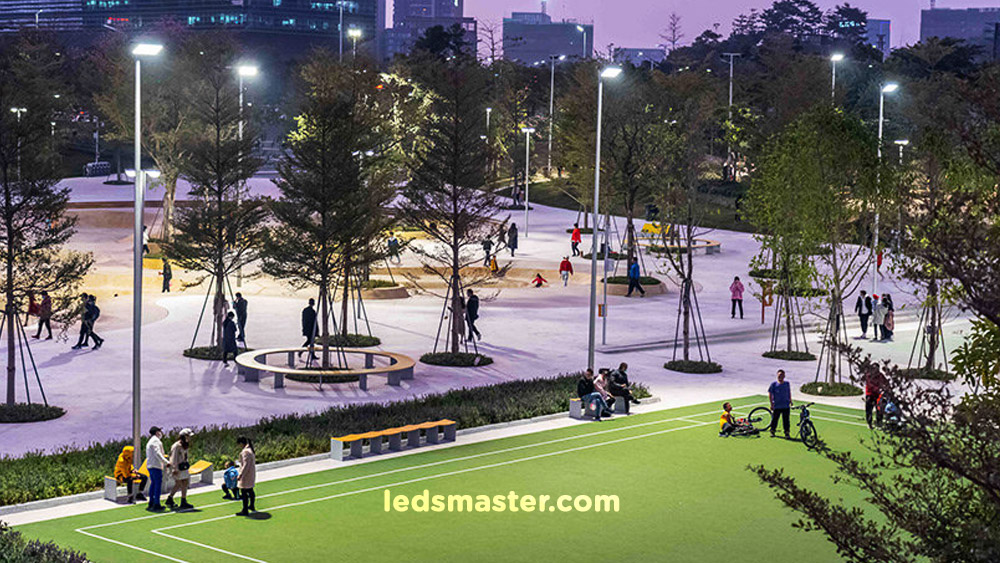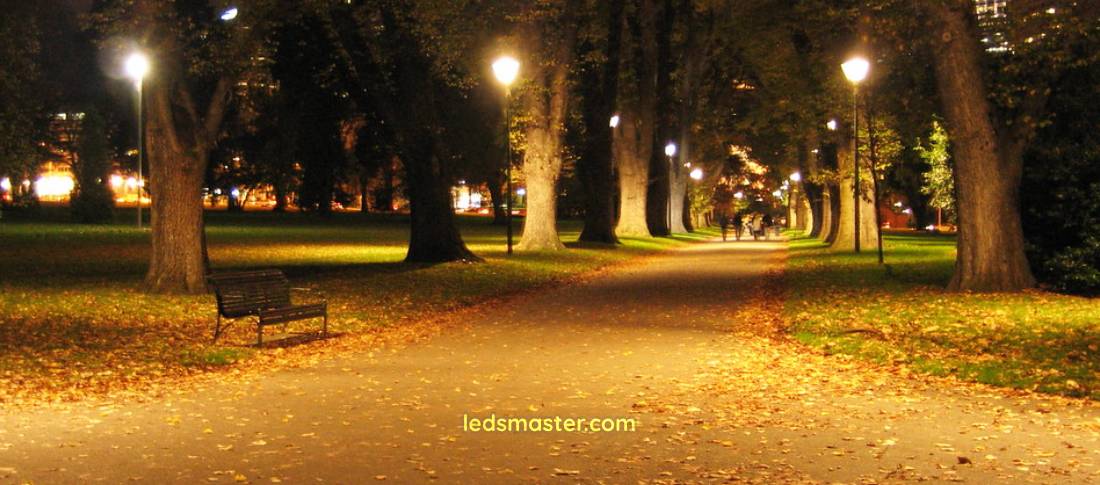Properly designed lighting systems illuminate pathways, recreational areas, and key landmarks, ensuring that visitors can navigate the park safely. The lighting design also emphasizes the park’s natural beauty by highlighting trees, water features, and sculptures, creating a welcoming atmosphere for nighttime visitors.
Even though the park has some lighting, it flickers from time to time. This would scare away the public. To optimize the use of public parks at night, a good lighting system is crucial.
LED is always the best choice because of its high lighting efficiency, long life and versatility. In this article, we will learn about the different parts of public park lighting.
Get your complimentary lighting design today
Table of Contents
ToggleWhen embarking on a lighting project for public parks, there are two approaches: lighting replacements and new installations. Lighting replacements involve upgrading existing fixtures to improve efficiency and effectiveness. Many parks may still utilize outdated lighting systems, such as metal halide or mercury vapor lamps, which can be inefficient and costly to operate. By replacing these fixtures with modern LED lights, parks can significantly reduce energy consumption and improve light quality. The advantages of lighting replacements are manifold. Upgrading existing systems allows park managers to retain the overall structure of their parks while enhancing safety and aesthetics.
Moreover, it enables them to achieve better light distribution, reduce glare, and lower energy costs. As municipalities look to modernize their public spaces, lighting replacements become a vital aspect of park revitalization efforts.

For parks that are newly developed or undergoing renovations, new installations provide an opportunity to create a customized lighting design that meets contemporary standards. New installations allow for comprehensive planning, ensuring that lighting integrates seamlessly with landscaping and park features. With new installations, designers can consider the specific needs of different park areas, including sports fields, playgrounds, and pathways.
The design can incorporate advanced technologies, such as smart lighting controls and energy-efficient fixtures, which enhance both the environmental impact and the user experience. This approach fosters a sense of community ownership and encourages visitors to utilize the park after dark.
Sports fields are a common feature in public parks, serving as venues for community recreation and organized sports activities. Effective lighting is essential to ensure that these fields are safe and enjoyable for all participants, whether they are playing soccer, cricket, or engaging in other activities. To ensure visibility during evening games, the lighting must achieve a level of brightness that supports the sport being played. Typically, a range of 200 to 300 lux is recommended for recreational sports fields. This level of illumination allows players to see the ball and their teammates clearly while providing adequate visibility for spectators.
Uniform lighting distribution avoid shadows and bright spots, which can disrupt gameplay. Properly designed lighting systems can provide consistent illumination across the entire field, enhancing both safety and performance. Reducing glare is another essential factor; glare can be distracting and uncomfortable for players and spectators alike. Advanced optical technologies can minimize glare by using fixtures that direct light downward and reduce spill light. This focus on glare reduction enhances the overall experience for everyone involved.
The placement of lighting fixtures achieve optimal illumination. Lighting poles should be positioned strategically to cover the entire playing area without obstructing play. Additionally, consideration should be given to potential light pollution affecting nearby residential areas. Selecting energy-efficient lighting solutions can significantly reduce operational costs. LEDs, for example, consume considerably less energy than traditional fixtures while providing superior light quality.
By addressing these factors, park managers can create an inviting atmosphere for sports activities, encouraging community members to participate in healthy outdoor pursuits.
Playgrounds are components of public parks, offering children a space to play and socialize. Proper lighting design in these areas enhances safety while creating a welcoming environment for families. To ensure safety during nighttime play, lighting levels in playgrounds should ideally range from 50 to 150 lux. This range provides enough illumination for children to navigate play equipment and avoid obstacles while promoting a sense of comfort for parents supervising their children.
Thoughtful lighting design can help reduce accidents and injuries in playgrounds. Well-placed fixtures illuminate pathways and play structures, allowing children to see potential hazards. This proactive approach enhances overall safety and encourages parents to allow their children to explore the space confidently. Moreover, lighting can enhance the visual appeal of playgrounds. Incorporating colorful LED lights can create an enchanting atmosphere that captivates children’s imaginations.
Dynamic lighting effects, such as color-changing displays, can make the playground a fun destination during evening hours. By creating a safe and inviting atmosphere, playground lighting can encourage families to use the park after dark, fostering community engagement and promoting social interactions that strengthen neighborhood bonds. Additionally, incorporating energy-efficient LEDs in playground designs contributes to lower energy consumption. These sustainable solutions align with broader environmental goals and demonstrate a commitment to preserving natural resources.
Through careful planning and execution, playground lighting can provide a secure and enjoyable environment for children and families.
Public parks often feature meadows, fountains, and sidewalks that serve as gathering places for visitors. Enhancing the lighting in these areas improves visibility while adding a layer of aesthetic beauty to the park. Meadows are open spaces where visitors can relax and enjoy nature. Effective lighting design in meadows prioritizes subtle illumination; lighting should be subtle and not overpowering. Soft illumination creates a serene atmosphere while encouraging nighttime visitors to enjoy the tranquility of the space.
Strategic lighting can highlight natural features, such as trees and flowerbeds. By using uplights and pathway lights, parks can create enchanting visual displays that draw visitors in. Adequate lighting along walking paths ensures that visitors can navigate the meadow safely. Pathway lights can guide users while enhancing the park’s overall aesthetic.
Fountains, often focal points in public parks, provide a space for relaxation and reflection. Incorporating lighting into fountain design can transform them into stunning visual attractions, particularly at night. Using color-changing LED lights, fountains can feature dynamic lighting effects that synchronize with the water flow. This approach creates an engaging visual experience that captivates visitors and encourages them to spend more time in the park.
Proper lighting around fountains illuminate the surrounding area so that visitors can see the edges of the fountain and navigate around it without risk. Sidewalks play a crucial role in connecting different areas of the park. Well-designed sidewalk lighting enhances safety and accessibility for all users. Ensuring uniform lighting along sidewalks is crucial for preventing dark spots and shadows that could pose safety risks. Consistent illumination allows pedestrians to navigate the park safely, especially during evening hours, and enhances the overall experience.
Thoughtful placement of sidewalk lights can enhance the park’s visual appeal while preserving the natural landscape, maintaining the park’s aesthetic integrity. By focusing on the unique lighting needs of meadows, fountains, and sidewalks, parks can create inviting spaces that draw visitors in and foster a sense of community.
Parking lots serve as access points for public parks, allowing visitors to arrive safely and conveniently. Proper lighting design in parking areas is essential for ensuring safety and enhancing the overall park experience. Illumination levels in parking lots should be approximately 50 to 150 lux, providing sufficient brightness for visibility while maintaining a welcoming environment. Ensuring uniform lighting across the parking area is crucial for preventing dark spots and shadows, which could disrupt safety.
Consistent illumination allows drivers and pedestrians to see one another clearly, reducing the likelihood of accidents. Well-lit parking lots deter criminal activity and create a sense of security for visitors. Bright lighting enables CCTV cameras to capture clearer images, enhancing safety for park users. As with other park lighting areas, energy-efficient LED solutions should be used in parking lot lighting designs.
The reduced energy consumption not only lowers operational costs but also aligns with sustainability initiatives. Additionally, accessible parking spaces should be well-lit to ensure safety for individuals with disabilities. Adequate lighting in these areas promotes inclusivity and provides peace of mind for all visitors. By prioritizing safety, visibility, and accessibility in parking lot lighting design, parks can enhance the overall visitor experience while encouraging more people to explore these public spaces.

Transitioning to LED lighting technology offers numerous benefits for public parks, improving energy efficiency, safety, and overall visitor satisfaction. One of the primary advantages of LED lighting is its energy efficiency. LED lights consume significantly less energy than traditional lighting systems, resulting in reduced operational costs. For example, replacing outdated lighting with LED fixtures can lead to energy savings of up to 75% to 85%. This reduction in energy consumption translates to lower utility bills, making it a cost-effective solution for municipalities.
Furthermore, LED lights have a longer lifespan compared to traditional lighting options. While conventional bulbs may need frequent replacement, LEDs can last for years, reducing maintenance costs and the frequency of service calls. This longevity contributes to overall sustainability, as fewer bulbs end up in landfills. Another significant benefit is the quality of light that LEDs provide. They emit bright, clear light that enhances visibility and safety in public parks. The ability to control the color temperature of LED lights allows for customizable lighting solutions that can create the desired atmosphere for different park areas.
In addition to energy savings and longevity, LED lighting enhances safety for park visitors. The bright, uniform illumination provided by LEDs increases visibility, making it easier for pedestrians and cyclists to navigate the park safely. This improved visibility also deters potential criminal activity, as brightly lit areas are less attractive to those with ill intentions. The perception of safety in public parks is crucial for encouraging community engagement and ensuring that families feel comfortable using the park after dark.
The incorporation of smart lighting controls further enhances the advantages of LED technology. Municipalities can implement adaptive lighting systems that adjust brightness levels based on real-time usage patterns. For instance, lights can dim during low-traffic times or activate only when motion is detected. This approach not only contributes to energy savings but also enhances the overall user experience.
Adopting LED technology aligns with broader sustainability goals, as municipalities increasingly focus on reducing their carbon footprint and improving environmental responsibility. By utilizing environmentally friendly LED lights, public parks can contribute to this initiative while enhancing the park experience for visitors. The elimination of harmful UV radiation emitted by traditional lighting is another advantage of LED technology.
This is particularly relevant for sensitive populations, such as children and the elderly, who may be more susceptible to the effects of UV exposure. By investing in LED lighting solutions, public parks can become safer spaces that encourage community engagement and provide a welcoming environment for all.
Effective lighting design enhance the safety, functionality, and aesthetics of public parks. By considering the unique lighting needs of various park areas, such as sports fields, playgrounds, meadows, fountains, sidewalks, and parking lots, park planners can create inviting spaces that foster community engagement.
The transition to LED technology offers numerous benefits, including energy efficiency, improved light quality, and enhanced safety for park visitors. By investing in thoughtful lighting design, municipalities can ensure their public parks remain welcoming and vibrant spaces for all members of the community.